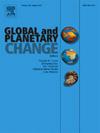IF 4
1区 地球科学
Q1 GEOGRAPHY, PHYSICAL
引用次数: 0
摘要
本研究介绍了位于东阿拉伯海(EAS)水深 182 米处的岩芯 SK291/GC17 中的底栖有孔虫组合、浮游有孔虫 Globigerina bulloides 的相对丰度、底栖有孔虫 Uvigerina peregrina 的稳定同位素比值以及黄铁矿化特征的多代理记录。该沉积物岩芯的年代为距今 ∼ 40,000 年至 3500 年(公元前)。G. bulloides 的明显高丰度表明,在公元前 4 万至 2.9 万卡年(相当于海洋同位素阶段 3(MIS3)晚期),东阿拉伯海在强烈的印度夏季季风(ISM)驱动下出现了强烈的上升流和高生产力。由于 MIS3 阶段的海平面低于近代,岩芯与海岸的距离更近,有助于大量大陆流入,从而导致沉积物-水界面的富营养化和缺氧状态。这种缺氧状态从含氧底栖有孔虫及其极低的物种多样性中可见一斑。在 MIS 3 期间,观察到褶皱黄铁矿聚集体,这表明富含铁的大陆物质流入研究岩芯,然后在缺氧环境中发生黄铁矿化。在末次冰川极盛时期(LGM),较低的海平面和较弱的 ISM 使岩心 SK291/GC17 处于相对中营养(含氧量较高)的状态。核心区 SK291/GC17 在 MIS 3 晚期的极度富营养化及相关缺氧条件在较年轻的区间从未经历过,G. bulloides 的百分比持续下降。本文章由计算机程序翻译,如有差异,请以英文原文为准。
Changes in surface conditions and associated hypoxia since the late Marine Isotope Stage 3, eastern Arabian Sea
This study presents multiproxy record of benthic foraminiferal assemblages, relative abundances of planktic foraminifer Globigerina bulloides, stable isotope ratios in benthic foraminifer Uvigerina peregrina, and signature of pyritization from Core SK291/GC17, located at a water depth of 182 m in the eastern Arabian Sea (EAS). The sediment core covers an age from ∼40,000 to 3500 calibrated years before present (cal yr BP). Distinctly high abundance of G. bulloides, suggests strong upwelling and high productivity driven by intense Indian summer monsoon (ISM) winds in the EAS during ∼40,000–29,000 cal yr BP, corresponding to the late Marine Isotope Stage 3 (MIS3). As the sea level was lower than the recent time in the MIS3, closer proximity of the core to the coast aided high continental influx, which led to eutrophic, oxygen deficient condition at the sediment-water interface. This hypoxic condition is evident from the subjugation of oxic benthic foraminifera and their very low species diversity. Framboidal pyrite aggregates were observed during the MIS 3, suggesting iron-rich continental influx to the study core followed by pyritization in the anoxic environment. During the Last Glacial Maximum (LGM), a lower sea level and weak ISM caused relatively mesotrophic (and better oxygenated) condition over Core SK291/GC17. The extreme eutrophic and associated hypoxic condition in the late MIS 3 at Core SK291/GC17 was never experienced in the younger intervals, with G. bulloides percentages showing continuous decrease.
求助全文
通过发布文献求助,成功后即可免费获取论文全文。
去求助
来源期刊

Global and Planetary Change
地学天文-地球科学综合
CiteScore
7.40
自引率
10.30%
发文量
226
审稿时长
63 days
期刊介绍:
The objective of the journal Global and Planetary Change is to provide a multi-disciplinary overview of the processes taking place in the Earth System and involved in planetary change over time. The journal focuses on records of the past and current state of the earth system, and future scenarios , and their link to global environmental change. Regional or process-oriented studies are welcome if they discuss global implications. Topics include, but are not limited to, changes in the dynamics and composition of the atmosphere, oceans and cryosphere, as well as climate change, sea level variation, observations/modelling of Earth processes from deep to (near-)surface and their coupling, global ecology, biogeography and the resilience/thresholds in ecosystems.
Key criteria for the consideration of manuscripts are (a) the relevance for the global scientific community and/or (b) the wider implications for global scale problems, preferably combined with (c) having a significance beyond a single discipline. A clear focus on key processes associated with planetary scale change is strongly encouraged.
Manuscripts can be submitted as either research contributions or as a review article. Every effort should be made towards the presentation of research outcomes in an understandable way for a broad readership.
 求助内容:
求助内容: 应助结果提醒方式:
应助结果提醒方式:


